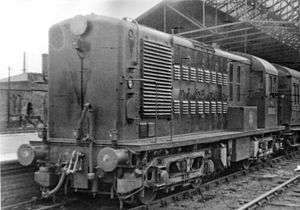British Rail 10800
British Railways 10800 was a diesel locomotive built by the North British Locomotive Company for British Railways in 1950. It had been ordered by the London, Midland and Scottish Railway in 1946 but did not appear until after the 1948 nationalisation of the railways.
| British Railways 10800 | |||||||||||||||||||||||||||||||||||||||||||||||||||
|---|---|---|---|---|---|---|---|---|---|---|---|---|---|---|---|---|---|---|---|---|---|---|---|---|---|---|---|---|---|---|---|---|---|---|---|---|---|---|---|---|---|---|---|---|---|---|---|---|---|---|---|
 10800 on the down main platform at Rugby | |||||||||||||||||||||||||||||||||||||||||||||||||||
| |||||||||||||||||||||||||||||||||||||||||||||||||||
| |||||||||||||||||||||||||||||||||||||||||||||||||||
| |||||||||||||||||||||||||||||||||||||||||||||||||||
| |||||||||||||||||||||||||||||||||||||||||||||||||||
Design was by George Ivatt and the locomotive was intended as a possible replacement for steam locomotives on secondary and branch lines. The single-cab layout (long bonnet forward) gave the driver a poor view of the road ahead. The view was no worse than a steam locomotive's, so it would have been considered acceptable at the time.
During its brief time on the Southern Region between 1952 and 1954, 10800 gained the nickname 'The Wonder Engine', from the locomotive department's daily query, 'I wonder if it will go today'.[1]
Description
Due to having been ordered by the LMS before the creation of British Railways (BR), 10800 became the first BR mixed-traffic Diesel-Electric locomotive when it was delivered in 1950. Operationally it was successful enough for BR to order two classes of 54 similar locomotives in 1955[2] although these, destined to become BR Class 15 and BR Class 16, used the improved YHXL engine.
Extra Information
- Bogie wheelbase: 8 ft 6 in (2.591 m)
- Bogie pivot centres: 22 ft 6 in (6.86 m)
- Sanding equipment: Pneumatic
- Heating type: Steam (Water-tube boiler) (Clarkson thimble tube boiler) – Clarkson[3]
- Main generator type: BTH
- Aux generator type: BTH
- Gear ratio: 66:15
- Boiler water capacity: 300 imp gal (1,400 l; 360 US gal)
- Boiler fuel capacity:* 90 imp gal (410 l; 110 US gal)
Rebuilding as an AC transmission prototype
In 1961 No. 10800 was bought by Brush Traction and rebuilt for experiments in AC power transmission. Brush named the locomotive Hawk.[4] DC transmission in diesel-electric locomotives was reaching its limits, at least for single-generator locomotives.[lower-roman 1] The brushgear and commutator of a DC generator became prone to flashover for engine powers greater than around 2,700 bhp. The most straightforward solution, rather than redesigning the DC generator, was to adopt an AC alternator instead, which could use a much simpler slipring connection to its field rotor rather than a commutator.[lower-roman 2]
Although the advantages of AC transmission were obvious, the best means to implement suitable traction motors was not. Should these be the familiar DC motors (requiring AC–DC rectification)? Or should AC traction motors be developed, and if so, how would their speed be controlled?[lower-roman 3] High-power solid-state electronics was in an early state at this time, although Brush were keen to become leaders in the field.
A more powerful engine would be required, to give a realistic trial, and Brush already had a suitable one on hand, as a spare from the development of Falcon. This was a Maybach MD655 of 1,400 bhp. The Maybach was also a high-speed diesel engine, running at 1,500 rpm rather than the Paxman's 1,250 rpm. The Paxman was itself considered a high-speed engine, running significantly faster than the English Electric or Sulzer medium-speed (< 1,000 rpm) engines which had been adopted for high-powered British Railways locomotives. The new 100Hz AC generator was rated at 950 kW (1,270 bhp), a conversion efficiency of 91%. The output was at 1,325V / 600A.[4] New AC traction motors were used, with squirrel cage motors supplied by thyristor variable-frequency drives.[6]
Brush's experience with AC transmission, gained with Hawk, would be put to use a few years later with the development of the 4,000 bhp single-engined AC transmission HS4000 Kestrel.
Hawk was used until 1968, after which its control equipment was becoming irrelevantly obsolete and was superseded by the direct experience from Kestrel.[7] During the 1972 miners' strike the engine and generator were removed as a standby generator for the Brush Falcon works. After this, parts began to be stripped until it was finally scrapped around 1976.
References
- The Deltics had twin engines and generators. Brush's prototype Falcon had also used twin engines and generators.
- The main improvement is that for the DC generator, the large output current is taken from the rotor and so must pass through the commutator. For the AC alternator, only the much smaller field current needs to be supplied to the rotor and the output current is taken from the static field coils.
- The same question had arisen in France in the mid-1950s, for their 25 kV 50 Hz AC electrification project. Four similar classes of electric locomotive, the BB 12000, BB 13000, CC 14000 and CC 14100 classes, each using a different method, had been produced and tested.[5]
- "Ivatt 800hp Diesel Electric Locomotive". Southern E-Group. 10 August 2004.
- Carr, Richard (29 October 2008). "Paxman and Diesel Rail Traction". Richard Carr's Paxman History Pages. Retrieved 2 December 2008.
- "Clarkson Thimble Tube Boiler Co". Grace's Guide to British Industrial History. 4 September 2013.
- Clough (2005), pp. 22–24.
- Cuynet, Jean (2008). "Les débuts du courant "industriel" à la SNCF" [The beginnings of 'industrial' current on the SNCF] (PDF). J3eA, Journal sur l'enseignement des sciences et technologies de l'information et des systèmes (in French). EDP. 7: 1–13. doi:10.1051/j3ea:2008040. Retrieved 1 September 2017.CS1 maint: ref=harv (link)
- "The experimental Brush 'Hawk'". Modern Railways. March 1965. p. 170. ISSN 0262-561X.
- Clough (2005), p. 24.
Further reading
- Clough, David N. (2005). "Early Post-Nationalisation Prototypes". Nº10800 and Hawk. Diesel Pioneers. Ian Allan. pp. 20–24. ISBN 978-0-7110-3067-1.
- Clough, David N. (2011). "2: Diesel-Electric Development after 1945". Hydraulic vs Electric: The battle for the BR diesel fleet. Ian Allan. pp. 18–19. ISBN 978-0-7110-3550-8.
- Toms, George (January 1984). "The 'Hawk' project". Rail Enthusiast. EMAP National Publications. pp. 8–11, 13. ISSN 0262-561X. OCLC 49957965.